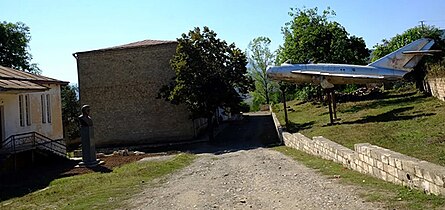Boyuk Taghlar
Boyuk Taghlar / Mets Tagher
Böyük Tağlar / Մեծ Թաղեր | |
|---|---|
 | |
 Boyuk Taghlar / Mets Tagher  Boyuk Taghlar / Mets Tagher | |
| Coordinates: 39°37′06″N 46°57′17″E / 39.61833°N 46.95472°ECoordinates: 39°37′06″N 46°57′17″E / 39.61833°N 46.95472°E | |
| Country | |
| District | Khojavend |
| Elevation | 900 m (3,000 ft) |
| Population (2015)[1] | |
| • Total | 1,509 |
| Time zone | UTC+4 (AZT) |
Boyuk Taghlar (Azerbaijani: Böyük Tağlar) or Mets Tagher (Armenian: Մեծ Թաղեր) is a village in the Khojavend District of Azerbaijan, in the disputed region of Nagorno-Karabakh. The village had an ethnic Armenian-majority population prior to the 2020 Nagorno-Karabakh war, and also had an Armenian majority in 1989.[2]
The Taghlar Cave is located in the southern part of the village.
Toponymy[]
The village was known as Mets Taghlar (Armenian: Մեծ Թաղլար; Russian: Мец Тагла́р; Azerbaijani: Mets Tağlar) during the Soviet period.[3] The name Mets Tagher derives from two Armenian words, Mets, meaning great, large, or big, and Tagh, meaning quarter (of a city).
History[]

During the Soviet period, the village was a part of the Hadrut District of the Nagorno-Karabakh Autonomous Oblast. The village came under the control of Armenian forces during the First Nagorno-Karabakh War, on October 2, 1992, and subsequently became part of the Hadrut Province of the Republic of Artsakh.
The village was captured by Azerbaijani forces on 9 November 2020 during the 2020 Nagorno-Karabakh war.[4]
In early May 2021, satellite images released by Caucasus Heritage Watch, a watchdog group made up of researchers from Purdue and Cornell, revealed that the local early 19th-century Armenian cemetery had been destroyed by Azerbaijani forces. Bulldozer tracks near the vicinity of the village's Holy Savior Church, founded in 1846, indicated that that building was also endangered.[5]
Satellite photography from July 2021 reveals the centre of the town and a large portion of the town's buildings have been bulldozed for the construction of the Fizuli-Shusha highway.
In August 2021, satellite images released by Caucasus Heritage Watch, revealed that the village's Makun Bridge, which was built in 1890, had been destroyed by Azerbaijan between April 8 and July 7, in the course of river engineering and road construction.[6]
Historical heritage sites[]
Historical heritage sites in and around the village include the cave of Shmanek (Armenian: Շմանեք), a village from between the 9th and 13th centuries, a 12th/13th-century khachkar, a cemetery from between the 17th and 19th centuries, a bridge built in 1835, and the Holy Savior Church (Armenian: Սուրբ Ամենափրկիչ Եկեղեցի, romanized: Surb Amenaprkich Yekeghetsi) built in 1846.[1]
Demographics[]
The village had 1,503 inhabitants in 2005,[7] and 1,509 inhabitants in 2015.[1]
Gallery[]
Entrance to the Holy Savior Church, built in 1846

Makun Bridge built in 1890

Bust of Sergei Khudyakov with MiG-17
Garden

Makun Bridge stone with construction inscription
Notable people[]
- Sergei Khudyakov, Soviet Marshal of Aviation
References[]
- ^ a b c Hakob Ghahramanyan. "Directory of socio-economic characteristics of NKR administrative-territorial units (2015)".
- ^ Андрей Зубов. "Андрей Зубов. Карабах: Мир и Война". drugoivzgliad.com.
- ^ Landmine Mapper. "Azerbaijan (& Nagorno Karabakh) Topographic Map 1:200,000 Russian Soviet Military". GigaPan.
- ^ Archived at Ghostarchive and the Wayback Machine: "Xocavənd rayonunun Böyük Tağlar kəndindən videogörüntülər". YouTube.
- ^ "ALERT: An Armenian cemetery in the village of Mets Tagher/Böyük Tağlar was recently destroyed...." Twitter. 4 May 2021.
- ^ "Between April 8 and July 7, the Makun Bridge in Mets Tagher/Böyük Tağlar was destroyed...." Twitter. 31 August 2021.
- ^ "The Results of the 2005 Census of the Nagorno-Karabakh Republic" (PDF). National Statistic Service of the Republic of Artsakh.
External links[]
| Wikimedia Commons has media related to Böyük Tağlar. |
- Populated places in Khojavend District
- Populated places in Hadrut Province
- Nagorno-Karabakh
- Former Armenian inhabited settlements






